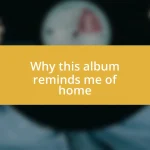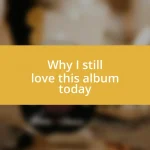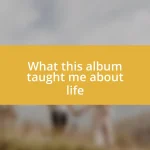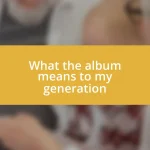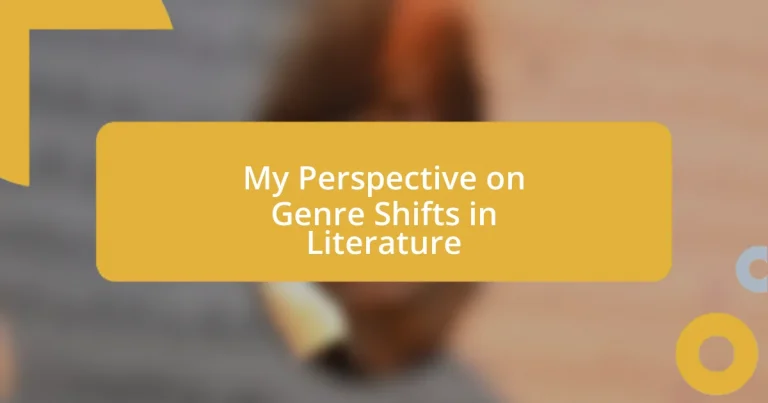Key takeaways:
- Genre shifts reflect evolving reader and writer experiences, breaking traditional boundaries to explore complex human narratives.
- Significant cultural movements and technological advancements have influenced genre evolution, promoting diverse literary voices and interactive storytelling.
- The future of literature will likely see innovative blends of genres and themes, especially around identity and the impact of technology on reader engagement.

Understanding genre shifts
Genre shifts are fascinating to me because they reflect the evolving tastes and experiences of readers and writers alike. I remember picking up a novel that started as a romance but seamlessly transitioned into sci-fi halfway through. It left me wondering, how do genres interact to tell complex stories that feel both fresh and familiar?
As I’ve dabbled in reading across genres, I’ve noticed how shifts can trigger powerful emotions. For instance, when a thriller suddenly delves into a character’s backstory, it transforms the narrative from merely suspenseful to deeply personal. This blend made me reconsider the rigid boundaries we impose on genres—shouldn’t literature be about breaking those molds to explore human experiences in all their intricacies?
Thinking about my own writing journey, I’ve experimented with blending genres, too. When writing a short story that started as a horror piece but veered into comedy, I felt a thrill of creativity that was unmatched. It’s almost liberating to play with readers’ expectations and to ask, what happens when genres collide? Shifts in genre can lead to captivating narratives that resonate on multiple levels, enriching our collective literary landscape.
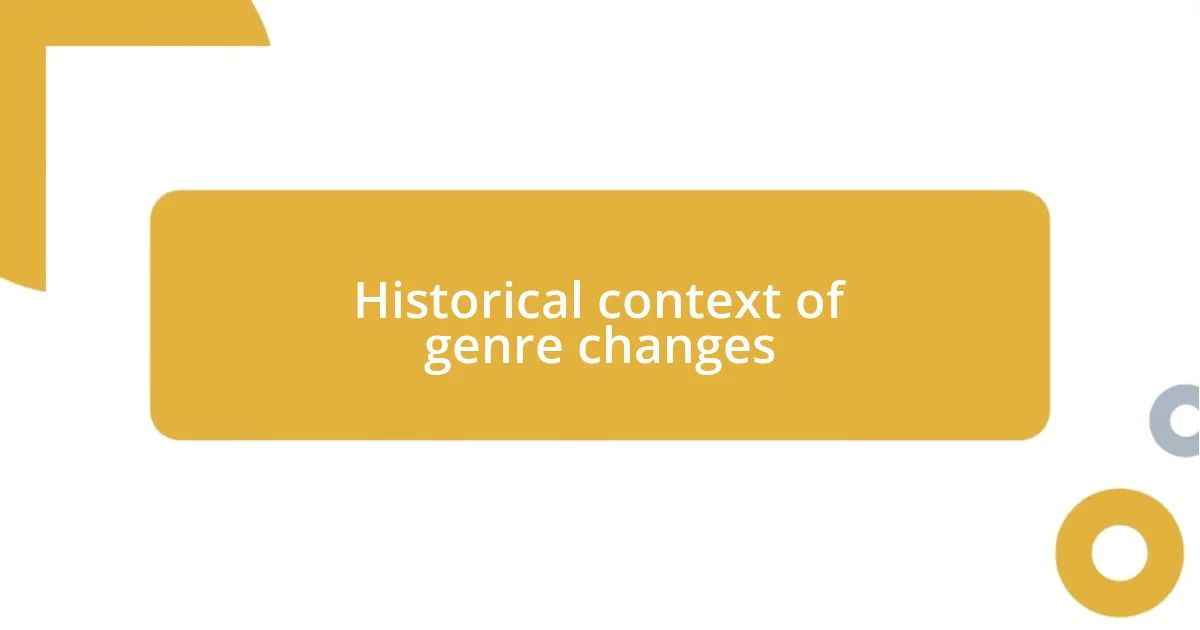
Historical context of genre changes
Genre evolution often mirrors significant societal changes. For instance, the rise of modernism in the early 20th century coincided with monumental shifts in technology and philosophy. I remember studying works from this period and feeling the profound influence of global events, like the World Wars, on themes and narrative structures—everything felt like a rebellion against traditional forms.
As I delve deeper into literary history, I see how genres interact with the cultural zeitgeist. The emergence of speculative fiction in the post-war era captivated me; authors like Ray Bradbury began blending everyday life with futuristic elements. This unique perspective made me reflect on my writing process, especially when attempting to infuse a current issue into a fictional setting, exploring what it means to envision the future while grounded in the present.
From my observations, genres also evolve as a response to reader engagement. In the late 20th century, the popularity of magical realism revealed our desire for fantastical elements in everyday storytelling. It truly excited me to see how writers like Gabriel García Márquez could take readers on vivid journeys through reality, adding extraordinary layers to seemingly normal lives. Have you ever felt that spark of wonder when a story transformed your understanding of the world? That’s the beauty of genre shifts—such changes cultivate a richer literary experience for both writers and readers alike.
| Time Period | Genre Evolution |
|---|---|
| Early 20th Century | Rise of Modernism reflecting societal shifts |
| Post-War Era | Emergence of Speculative Fiction inspired by current events |
| Late 20th Century | Popularity of Magical Realism showcasing everyday realities with fantastical elements |

Impact of technology on literature
In my experience, technology has drastically altered how we create and consume literature. The advent of e-books, for instance, has made literature widely accessible, leading to an explosion of self-publishing. I remember the excitement of discovering an indie author online whose voice resonated with me—this wouldn’t have been possible without platforms like Amazon Kindle Direct Publishing. It was a revelation to see stories from diverse perspectives rising out of the shadows of the traditional publishing world.
Moreover, the digital landscape has transformed storytelling techniques. Writers are now experimenting with multimedia, blending text with visuals, audio, and even interactive elements. I recall the immersive experience of reading a web-based narrative where clicking on links led to different story paths. It reminded me that literature isn’t confined to pages anymore; it has become a vibrant, multifaceted experience. Here are some key impacts of technology on literature:
- Increased Accessibility: Digital platforms allow readers from all walks of life to access a wider array of stories.
- Self-Publishing Boom: Writers can share their work without traditional gatekeepers, giving rise to unique voices.
- Interactive Storytelling: Technology enables immersive experiences, merging text with audio and visuals to enhance narratives.
- Social Media Engagement: Authors now interact directly with their readers, creating communities and fostering discussions about their work.
- Global Reach: Literature can transcend borders, as writers share cultural narratives with a global audience through digital channels.
Reflecting on these changes, I often think about how they inspire new forms of creativity. What an exhilarating time to be a writer or reader! The landscape of literature is continually evolving, and I can’t wait to see where technology takes us next.
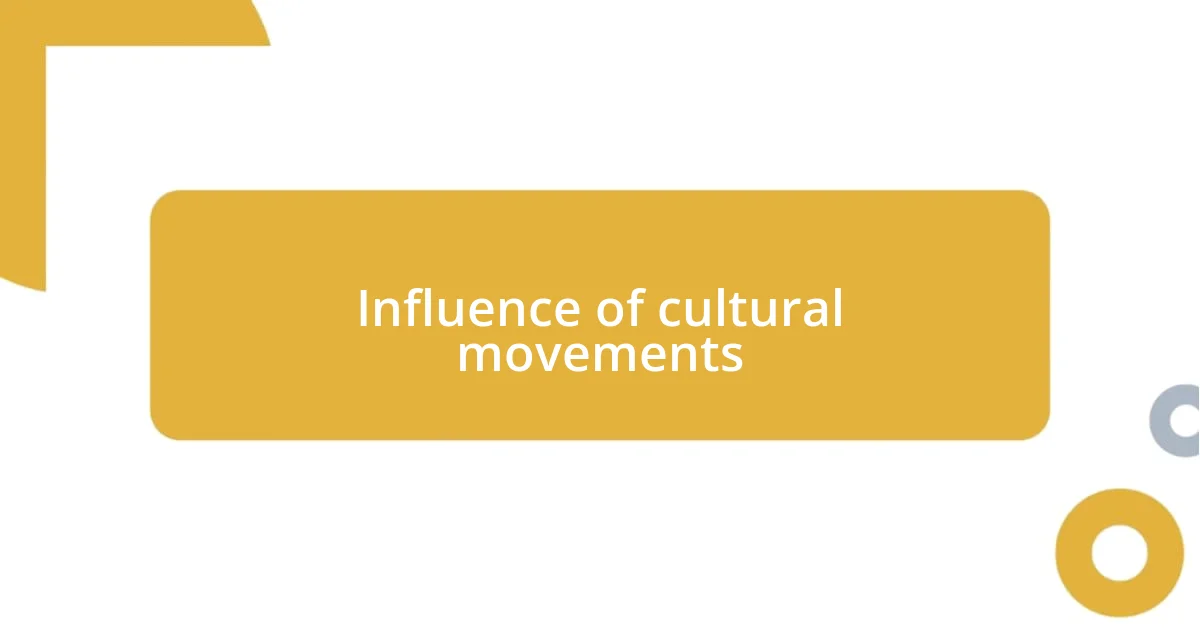
Influence of cultural movements
Cultural movements have always been a driving force behind shifts in literary genres. For instance, during the 1960s and 70s, the counterculture movement sparked a wave of anti-establishment literature. I vividly recall reading works like “The Electric Kool-Aid Acid Test” by Tom Wolfe, which not only captured the essence of the era’s rebellion but also reshaped the expectations of narrative style, embracing a more fragmented, experiential approach. Have you ever found a book that felt like it was speaking directly to the spirit of its time? Those moments are powerful.
As I reflect on various genres influenced by cultural shifts, the rise of feminism in the late 20th century stands out. The emergence of female voices, like those of Margaret Atwood and Toni Morrison, transformed literary landscapes, challenging traditional narratives and ultimately redefining genres such as dystopian fiction. I remember the profound impact “The Handmaid’s Tale” had on me, showcasing how literature can spark conversations about gender and power dynamics. It made me realize how crucial it is for writers to respond to the zeitgeist, weaving in contemporary concerns into the fabric of their stories.
Similarly, the environmental movement in recent decades has given rise to eco-criticism, impacting how we understand genre. Works like Richard Powers’ “The Overstory” not only tell compelling stories but also serve as a call to reckon with our relationship with nature. Reading that book moved me deeply; it felt like a gentle nudge to appreciate the world around us, reminding me that literature can be a vehicle for advocacy. Isn’t it fascinating how cultural movements shape not just what stories are told, but how they resonate with readers on a deeper level?
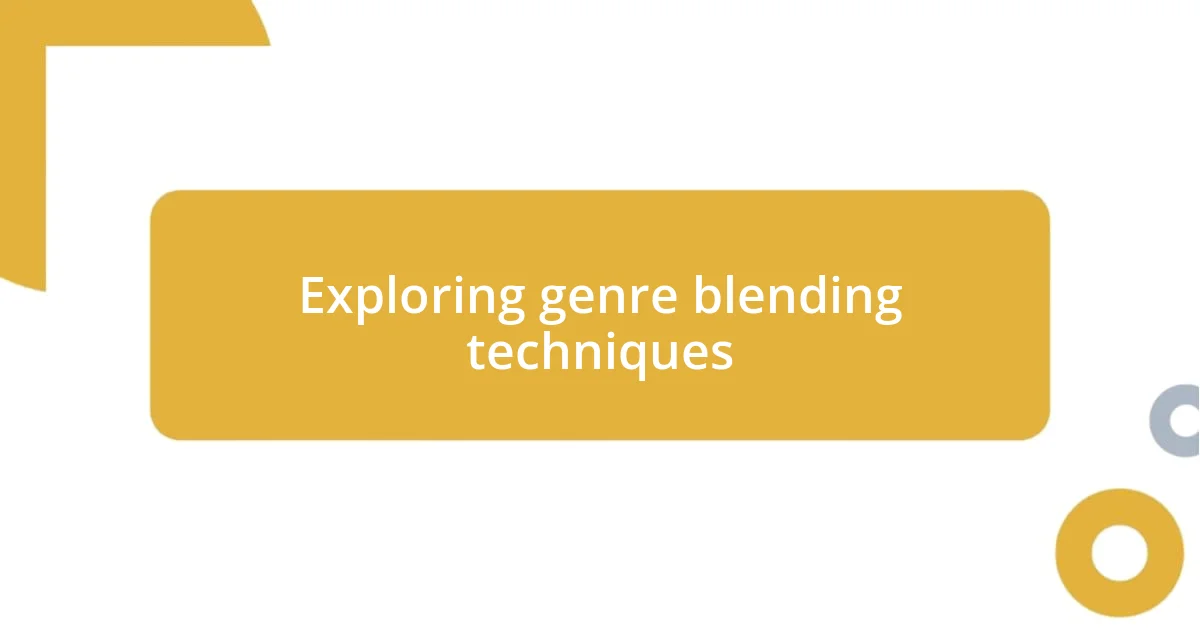
Exploring genre blending techniques
Genre blending techniques have become a powerful tool for writers looking to break traditional boundaries. I recently read a novel that seamlessly combined elements of science fiction and romance. The emotional depth of the relationship grounded the fantastical elements, making me feel connected to both the characters and their surreal world. Have you ever found yourself captivated by a story that managed to mix genres so well that it changed your perception of what a novel can be? Those experiences stay with me long after I turn the last page.
One technique I particularly admire is the use of unreliable narrators within genre blends. It pushes readers to question what they know and reevaluate the genre expectations. I remember being drawn into a mystery novel where the protagonist’s reality began to skew as elements of magical realism seeped in. It kept me guessing not just about the plot but also about the very nature of the narrative itself. Isn’t it thrilling when a story prompts you to engage your critical thinking in such an innovative way?
Another approach that fascinates me is the incorporation of subgenres into a main narrative. For instance, adding humor to a thriller can lighten the tension while keeping readers engaged. I once stumbled upon a quirky crime novel where witty dialogue balanced the suspense, making it a delightful read. It’s a reminder that blending genres can evoke a wider range of emotions and allow authors to explore complex themes with fresh perspectives. How can we not appreciate the creativity that genre blending brings to the literary landscape?
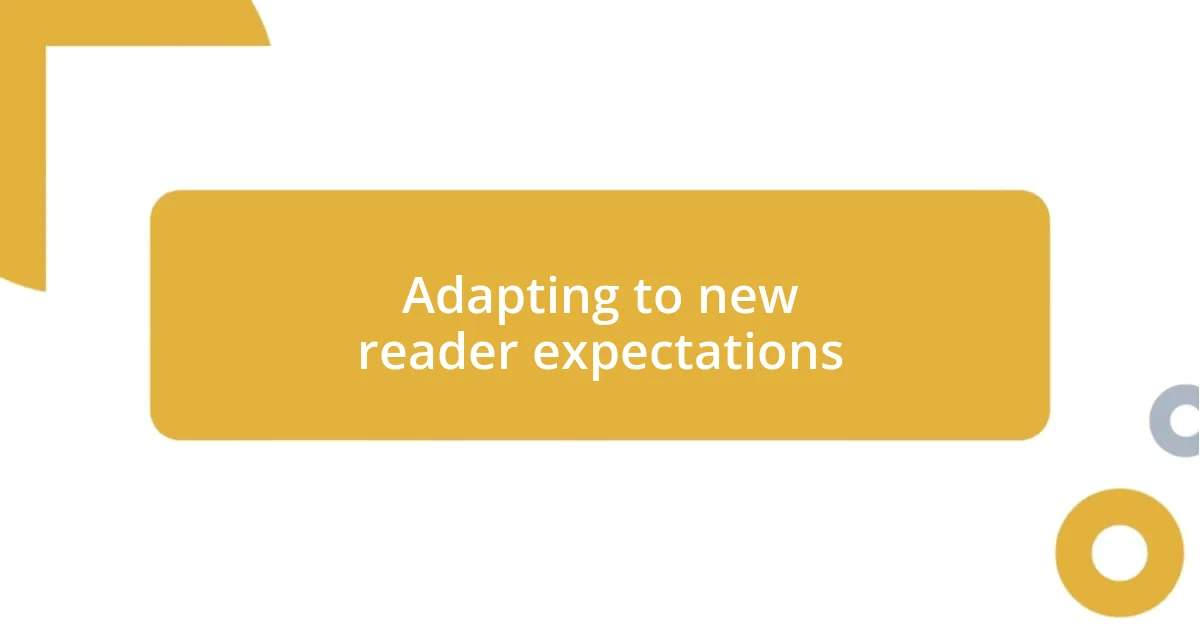
Adapting to new reader expectations
Adapting to new reader expectations has become essential for writers navigating the evolving landscape of literature. One of my favorite experiences was attending a book club where members discussed a contemporary novel that expertly played with reader preconceptions. The narrative was so self-aware that it almost felt like the author was having a direct conversation with us, challenging what we thought we knew about storytelling. I find it fascinating when books manage to surprise us, don’t you?
The changing dynamics of reader engagement also compel authors to embrace diversity and inclusion in their work. I recall reading a collection of short stories that highlighted voices from various cultural backgrounds, each piece offering a fresh perspective that enriched the overall tapestry of the book. It reminded me how literature can be a mirror reflecting the world we live in, and I felt grateful for the window into lives so different from my own. Isn’t it incredible how literature can foster empathy and understanding?
Furthermore, the rise of digital platforms has transformed how readers interact with stories, prompting writers to rethink their narrative techniques. I recently discovered a serialized novel online that left readers hanging at the end of each chapter, sparking excitement and eager anticipation for the next installment. Engaging with a story in real-time reminded me of the joy of weekly TV show rituals. How often do we get that level of involvement with a book? Writers who embrace these trends not only adapt to expectations but also create an immersive experience that resonates deeply with their audience.

Future trends in literary genres
The future of literary genres is likely to see even more innovative blends, as authors increasingly experiment with combining different styles and themes. I recently encountered a short story where dystopian elements met culinary arts, creating a deliciously strange world that explored societal issues through the lens of food. It made me think: could our cravings for both sustenance and meaning lead us to new genre possibilities? I believe that as readers seek more diverse narratives, writers will rise to the challenge.
Moreover, I anticipate that the themes of identity and belonging will play a crucial role in shaping future genres. I’ve noticed how often I connect to stories that delve into the experiences of marginalized characters navigating complex societies. The nuanced portrayals I’ve read have not only offered fresh perspectives but also sparked important conversations among my friends and me. Isn’t it exciting to think that literature might increasingly reflect our diverse realities, allowing us to walk in someone else’s shoes?
Finally, I see the influence of technology as a driving force in how future genres will evolve. Just the other day, while exploring interactive storytelling apps, I was blown away by how readers could choose their paths and influence the plot. It’s like being a co-author of your own reading experience! This kind of engagement invites questions about authorship and reader agency in storytelling. How will this reshape the boundaries of genres and the role of the writer? I can’t wait to find out!

